Chapter 2.
IMPERATOR ANDRONICUS KOMNIN OF THE XII CENTURY - IT IS JESUS CHRIST DURING HIS PRESENCE IN TSAR-GRAD OF THE XII CENTURY.
22. ANDRONICUS AND THE JUDEANS.
According to the Gospels the enemies of Jesus are the Judean high priests and teachers. Nicetas Choniates describes Andronicus as a Byzantine emperor. We will note that the life descriptions of the Byzantine emperors mention of the Judeans as the enemies of the emperor is quite a rare thing. When describing the execution of Andronicus’ opponents, the noble citizens of Czar-Grad - Doukas and Macrodoukas, Nicetas Choniates write the following: ‘Stephanos Hagiochristophorites …picked up a stone the size of his hand and threw it at Makrodoukas… he urged everyone to follow his example … The entire assembly picked up large stones and hurled them at the men… As the men were still breathing, certain attendants who were assigned this task lifted them up and wrapped them in the blankets… they carried Doukas to the opposite shore which had been SET ASIDE FOR THE BURIAL OF THE JEWS [140], p.305. Thus Choniates though very vaguely still mentions the Judeans speaking of the enemies of Andronicus. Once again there emerges an impression that what is before us is a text heavily edited by the more recent editor. Much of what was said in the original openly and straightforwardly is turned here into some vague and unclear hints.
We should also note the method of the execution itself – stoning. This is a Biblical type of execution, it is often mentioned both in the Old and the New Testaments. For example: ‘He who is without sin among you, let him be the first to throw a stone at her’ (John 8:7). Incidentally Choniates is also trying to ‘iron out the wrinkles’ and to present the stoning not as an execution, but only as the ‘preliminary torture’ stating that later Doukas and Macrodoukas were hanged. I.e. the executions were carried out not in the Biblical way, but in the usual Mediaeval way. Nevertheless one gets the impression that the original which ‘Nicetas Choniates’ worked on still referred to the Biblical stoning specifically.
23. STEPHEN PROTOMARTYR AND STEPHANOS HAGIOCHRISTOPHORITES WHO WAS THE FIRST MARTYR FOR ANDRONICUS.
In the history of the Christian Church it is known that the FIRST martyr for Christ was Archdeacon Stephen. See for example ‘Acts’, chapters 6-7, 8:1-2; and also [153], an article ‘Stephen, the Archdeacon and Protomartyr’. In fig.2.35 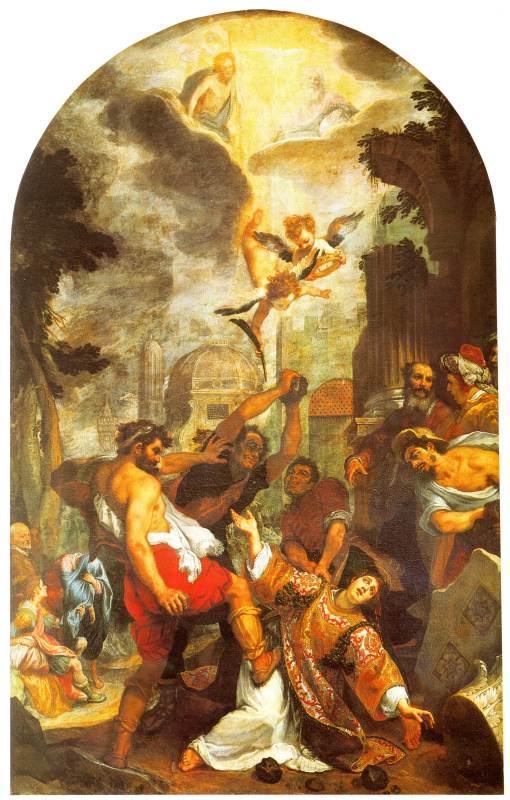 is represented one of the numerous old images of St. Stephen martyrdom.
is represented one of the numerous old images of St. Stephen martyrdom.
In the biography of Andronicus the FIRST of his attendants who died during the rebellion was named as the chief of the palace guards STEPHANOS Hagiochristophorites, i.e. translated from Greek into Russian ‘Stephen Supporter of Holy Christ. This is how Choniates describes the very beginning of the rebellion.
‘The hot and hasty Stephanos Hagiochristophorites, who cared for his lord and emperor in various ways, agreed to arrest Isaakios Angelos … He arrived at the house of Isaakios … and ordered Isaakios to descend and follow him… As was to be expected Isaakios delayed, speculating that as soon as he appeared the worst of all possible evils would befall him. Hagiochristophorites was resolved to use force… Isaakios saw that he could not escape… With sword drawn (his head was bare and over his body he wore a cloak…) he mounted his horse and raised his sword hand against the head of Hagiochristophorites … ISSAKIOS BROUGHT DOWN A MORTAL BLOW AND STRUCK THE POOR WRETCH IN THE MIDDLE OF HIS SKULL. Having cleaved him in twain, he let him lie there… As for Hagiochristophorites’ attendants, he terrified the one with his bare sword, cut off the ear of another, and another flying elsewhere whereupon all fled to their homes. Then Issakios rode at full speed towards the Great Church … He shouted out to all, that with this sword … HE HAD KILLED STEPHANOS HAGIOCHRISTOPHORITES … Those of the city populace … came streaming by the thousands to the Great Church… Among the others Isaakios’ paternal uncle, John Doukas, together with his son Isaakios, came to his assistance and hailed his act of sedition… Because none of the emperor’s supporters was present … neither from among the illustrious nobility nor from among those who retained Andronikos’ favour, nor axe-bearing barbarian, nor … lictors … the assembled throng became bold and excited … Andronicus was not present in the imperial palace, but was at the palace of Meloudion, situated on the eastern side of the strait leading into the Propontis.
Near the first watch of the night, he heard of Hagiochristophorites’ death he … addressed the citizens of the capital with a brief dispatch that exhorted them to desist from attempting to foment rebellion; it began as follows: ‘He who has received, has received; punishment has ceased’. In the early dawn, Andronicus’ attendants attempted to restrain the swelling mob, and Andronicus himself arrived at the Great Palace on an imperial trireme … Isaakios (Angelos – Author) was anointed emperor and … left the Great Church accompanied by Patriarch Basil Kamateros … When Andronicus arrived at the Great Palace … he gave his attention to resisting the mob and assembled his companions to go into battle … He soon realized that he was attempting to accomplish the impossible and spoke to the people through a messenger. He agreed to lay aside his crown and deliver it to his son Manuel … But exasperated more than ever by his words, the mob heaped the most atrocious insults on both him and his designated successor ... Because the multitude was now pouring inside the palace through the so-called Karea Gates, which had been broken down, Andronicus fled, taking off his purple-dyed buskins. Struck mad by God, on the way he REMOVED HIS ancient amulet and the CROSS from his neck and donned a barbarian cap that tapered to a point like a pyramid. Thus attired he boarded the same royal trireme…’ [140], p.349-354.
Thus the rebellion against Andronicus, culminating in his deposition, started exactly with the murder of Stephanos. It was him to be the first ‘martyr for Andronicus’. Besides Stephanos Hagiochristophorites was chief of the royal guards, i.e. was the chief attendant, the archdeacon in Greek. Like Stephen Protomartyr, the Christian Saint. He was the Archdeacon [153]. Therefore, the name of the first man, who died for Christ and the name of the first man who died for Andronicus are the same. It was Stephanos.
As a final point we would like to point out another solid parallel. Stephen Protomartyr was stoned [153]. The stoning mentioned above – incidentally the only one described by Nicetas Choniates – was also mentioned in connection with STEPHANOS Hagiochristophorites specifically. Though, according to Choniates it is Stephanos himself who is doing the stoning [140], p.305. But we understand that we are dealing not with the original text, but with its edited version. That is why who exactly was stoning whom depends on the affiliation of the chronicler. ‘Good people’ and the ‘evil’ ones often swapped places on the pages of the chronicles. But the very fact of stoning survived.
We will once again quote from Choniates: ‘Stephanos Hagiochristophorites …picked up a stone the size of his hand and threw it at Makrodoukas… he urged everyone to follow his example … The entire assembly picked up large stones and hurled them at the men…’ [140], p.305.
In fig.2.36 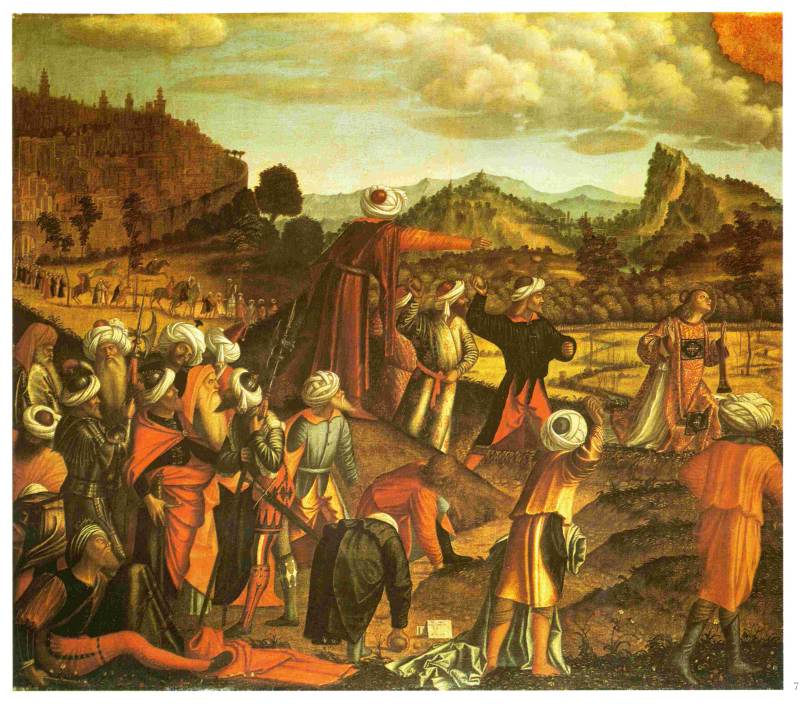 there is presented a painting by Carpaccio ‘The Stoning of St. Stephen’. Stephen is depicted on the right. He has already fallen on his knees and they are throwing stones at him. A central figure in a red royal garment standing on a hill and pointing at Stephen, draws our attention. It is possible, that this was the way of depicting Isaakios Angelos, who became an emperor that day. And who personally murdered Stephanos Hagiochristophorites, see above.
there is presented a painting by Carpaccio ‘The Stoning of St. Stephen’. Stephen is depicted on the right. He has already fallen on his knees and they are throwing stones at him. A central figure in a red royal garment standing on a hill and pointing at Stephen, draws our attention. It is possible, that this was the way of depicting Isaakios Angelos, who became an emperor that day. And who personally murdered Stephanos Hagiochristophorites, see above.
In fig.2.37 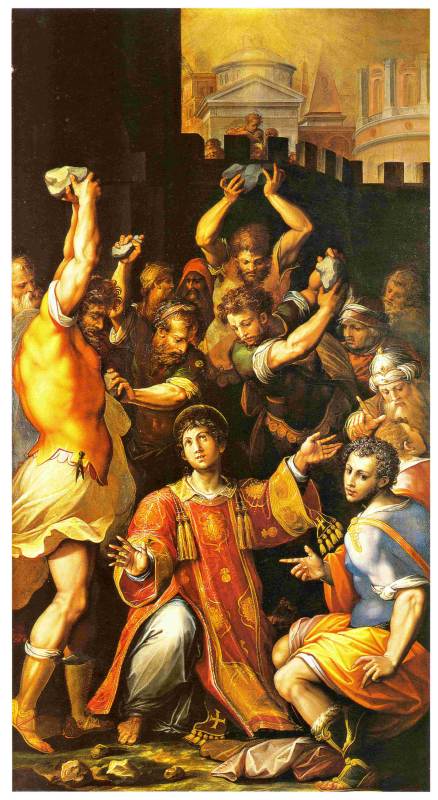 there is presented a painting by Giorgio Vasari ‘The Stoning of St. Stephen’. Here we also see a figure on the left emphasized with particularly bright, orange colours. The artist clearly wanted to draw the spectators’ attention to this man. He strikes Stephen. It could be Isaakios Angelos, who headed the rebellion against Andronicus and who killed Stephen with his own hands.
there is presented a painting by Giorgio Vasari ‘The Stoning of St. Stephen’. Here we also see a figure on the left emphasized with particularly bright, orange colours. The artist clearly wanted to draw the spectators’ attention to this man. He strikes Stephen. It could be Isaakios Angelos, who headed the rebellion against Andronicus and who killed Stephen with his own hands.
24. CHRIST REMOVES HIS HEAVY CROSS ON HIS WAY TO GOLGOTHA.
In the extract from Choniates given above there are several interesting details more which are worth mentioning. It is said for example that for some reason Andronicus REMOVED HIS CROSS FROM HIS NECK. Naturally Choniates interprets this as Andronicus’ unworthy action, and also an absolutely meaningless one. It is not clear why did he have to take off his baptismal cross, which it seems Choniates was referring to. In order to give some kind of explanation of this scene Choniates writes: ‘struck mad’, i.e. he attributes such action to Andronicus’ insanity.
But understanding that the text by ‘Choniates’ is a distorted edition of some old original and turning to the Gospels, we immediately find there a corresponding place. Notably, well-known to everyone. Christ was forced to carry a heavy cross to Golgotha. He could not carry the cross to the very end. Then THEY TOOK THE CROSS OFF HIM and gave it to another man. Who in his turn brought the cross to the place of execution. In fig.2.38 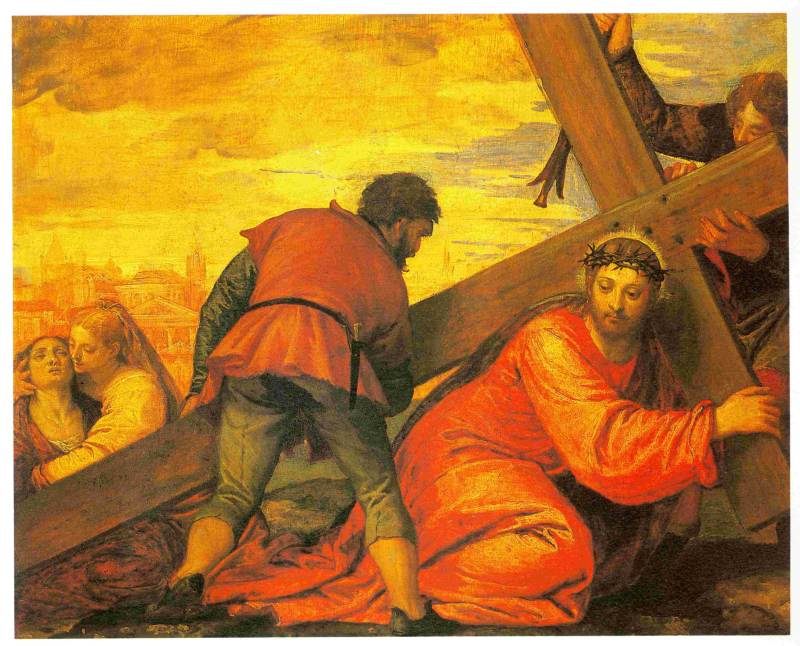 there is presented the painting by Veronese ‘Christ bearing the cross’ [87], p.265. Christ is collapsing under the weight of the cross. Behind him there is depicted Simon approaching him, taking the cross from the exhausted Jesus. The same scene of taking the cross ‘off Christ’s neck’ is shown in fig.2.39
there is presented the painting by Veronese ‘Christ bearing the cross’ [87], p.265. Christ is collapsing under the weight of the cross. Behind him there is depicted Simon approaching him, taking the cross from the exhausted Jesus. The same scene of taking the cross ‘off Christ’s neck’ is shown in fig.2.39 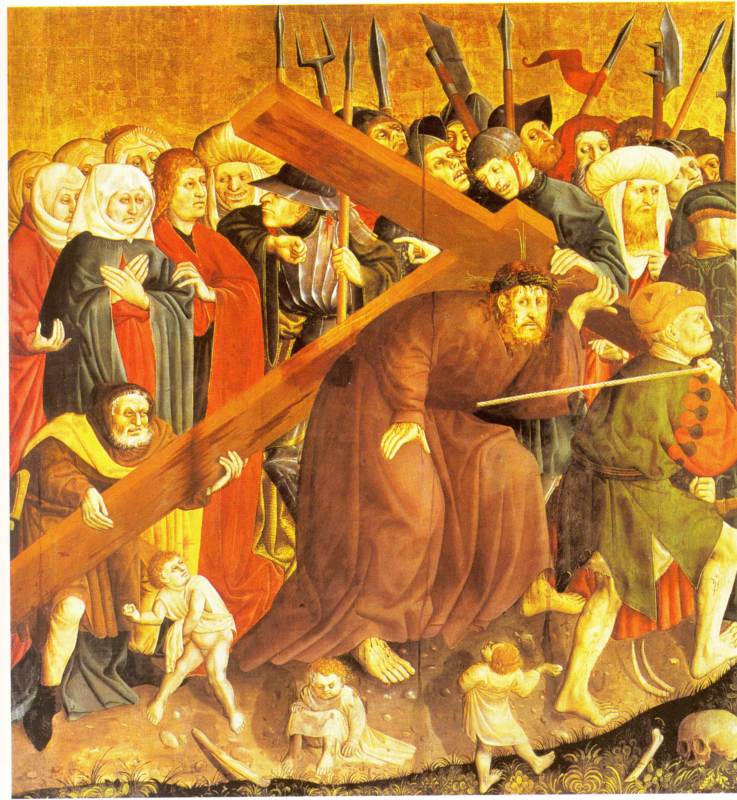 . There are many surviving depictions of this scene. See also for example the well-known engraving by A.Durer ‘Christ Carrying the Cross’ [171], fig.124.
. There are many surviving depictions of this scene. See also for example the well-known engraving by A.Durer ‘Christ Carrying the Cross’ [171], fig.124.
This is how the book ‘Strasti Christovy’ (‘Passion of Christ’) tells us about it:
"Взяша Господа нашего Исуса, Сына Божия, и поведоша Его на место Краниево, еже есть Лобное место (яко ту погребеся Адам) к горе Голгофе, на ней же имать распять быти. Еще же и крест на Него возложиша, и повелеша Ему нести до горы Голгофы. Исус же неможаше нестии от множества ран. Изшедше же из града, сретоша некоего человека киринейска, именем Симона, грядущего с села своего и сему повелеша крест понести, понеже бо видеша окаяннии Исуса изнемогающа, сами же влекоша его немилостиво до места, идеже распяти его хотяху" [127], лист 89.
The Gospels also speak (although not in much detail) of taking the cross off Christ and giving it to a certain passer-by to carry (Matthew 27:32; Mark 15:20-22; Luke 23:26; John 19:17). For example, Mark says: ‘ … they … led him out to crucify him. And they compel one Simon a Cyrenian, who passed by, coming out of the country, the father of Alexander and Rufus, to carry his cross. And they bring him unto the place Golgotha, which is also known as, The place of the skull’ (Mark 15:20-22).
Thus in the Gospel story Christ indeed removes the heavy cross, as he cannot carry it. It looks like this very event is reflected though vaguely in the narration of Nicetas Choniates, see above.
25. ANDRONICUS’ PYRAMIDAL HAT AND CHRISTIAN TIARA WORN BY THE POPE.
Here is another interesting place from the large fragment from Choniates given above. It says that Andronicus before fleeing ‘donned a barbarian cap that tapered to a point like a pyramid’ [140], p.354. But a pointed hat which looks like a pyramid is well-known in Christianity. It is a Papal tiara, see fig.2.40 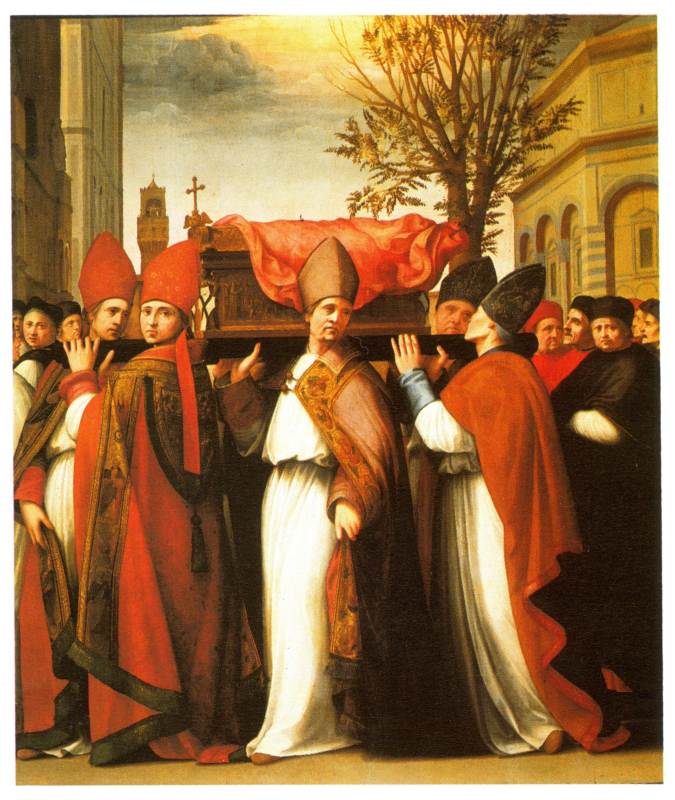 . And so we begin to understand the origins of this attire. Such a hat was worn by Christ-Andronicus.
. And so we begin to understand the origins of this attire. Such a hat was worn by Christ-Andronicus.
Incidentally it was called by Choniates a ‘barbarian cap’. Therefore, most likely, they did not wear it in Czar-Grad. Andronicus probably became accustomed to it in Russia, where he spent many years, see above. It is one of the types of a Russian cap (kolpak – in Russian). In fig.2.41 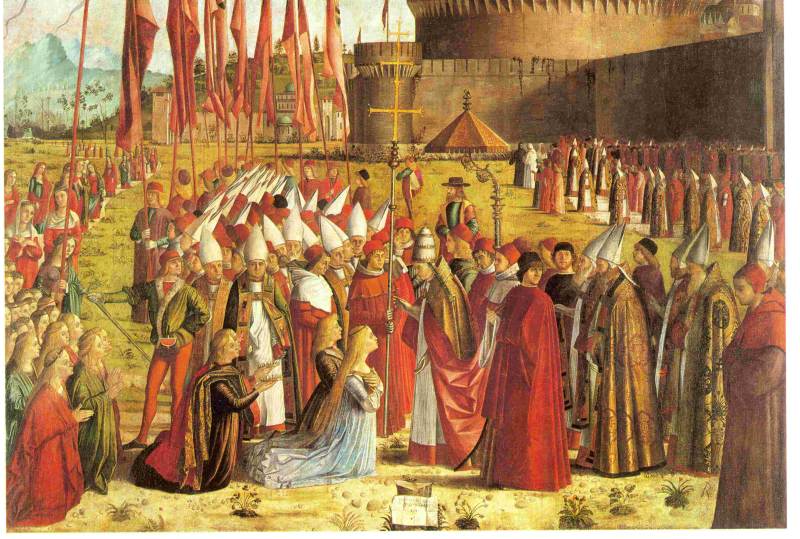 there is shown a fragment of the painting by Carpaccio ‘Legend of St. Ursula: The Meeting with the Pope’. We can see the pope wearing a pointed cap-kolpak on his head.
there is shown a fragment of the painting by Carpaccio ‘Legend of St. Ursula: The Meeting with the Pope’. We can see the pope wearing a pointed cap-kolpak on his head.
26. CHRIST HELD COURT AS A MAN IN A POSITION OF POWER.
It is well-known that many rulers, including those of Byzantium, quite often held court personally. But in the Gospels we encounter the direct references to the fact, that after entering Jerusalem, i.e. as we understand now, when he became the ruler of Czar-Grad, Christ HIMSELF PERSONALLY HELD COURT. ‘And early in the morning he came again into the temple, and all the people came unto him; and he sat down, and taught them. And the scribes and Pharisees brought unto him a woman taken in adultery; and when they had set her in the midst, They say unto him, Master, this woman was taken in adultery, in the very act. Now Moses in the law commanded us, that such should be stoned: but what sayest thou? … But Jesus stooped down, and with his finger wrote on the ground, as though he heard them not. So when they continued asking him, he lifted himself up himself, and said unto them, He that is without sin among you, let him first cast a stone at her. And again he stooped down, and wrote on the ground. And they which heard it … went out one by one … and Jesus was left alone, and the woman standing in the midst. When Jesus had lifted himself up, and saw none but the woman, he said unto her, Woman, where are those thine accusers? hath no man condemned thee? She said, No man, Lord. And Jesus said unto her, neither do I condemn thee: go, and sin no more’ (John 8:1-11).
Here we see the description of a judge set in authority, who when judging is seated in a certain elevated seat, as when addressing others he ‘lifts himself up’. And generally Christ is engaged with his own affairs: he is writing something, thinking about something and addresses the others clearly in a condescending manner. They are compelled to patiently await his reply. Finally he makes a decision and announces it to the people around him. The accused is put in the centre and the people speak out. The judgement is delivered. It is interesting that this Gospel scene was depicted exactly in this way by some artist even in the XVII century. Fig.2.42 shows a painting ‘Christ and the Woman Taken in Adultery’ by Rembrandt. In the foreground there are shown Christ-judge
shows a painting ‘Christ and the Woman Taken in Adultery’ by Rembrandt. In the foreground there are shown Christ-judge
and the sinner woman. In the background the same scene is depicted once more, but in a much more majestic way, see fig.2.43 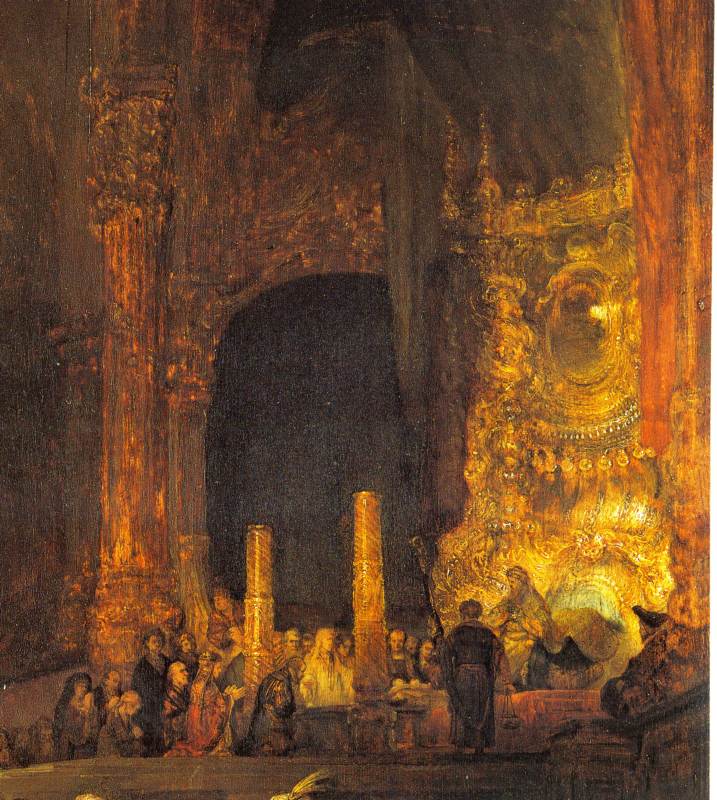 . Christ-judge is seated solemnly high up on a gigantic golden throne in a grand temple. In front of him a little bit below stands a woman surrounded by people. Many are on their knees. The entire scene is depicted in exact correspondence with the Gospels: ‘ … he came again into the temple, and all the people came unto him; and HE SAT DOWN, AND TAUGHT THEM’. (John 8:2). It is possible that in the times of Rembrandt there were two tendencies in the way Christ was depicted. One – the old and correct one – still remembered that Christ-Andronicus was an emperor, a judge and sat on a magnificent throne. The second tendency, the later one, was designed to the simplify the depiction of Christ as a holy man far removed from actual royal power, dressed modestly. Thus in his painting Rembrandt depicted both versions. Christ – a king and Christ – a prophet. We will remind you that the mediaeval artists sometimes depicted on the same canvas ‘a cartoon’, i.e. two or even several interchangeable scenes.
. Christ-judge is seated solemnly high up on a gigantic golden throne in a grand temple. In front of him a little bit below stands a woman surrounded by people. Many are on their knees. The entire scene is depicted in exact correspondence with the Gospels: ‘ … he came again into the temple, and all the people came unto him; and HE SAT DOWN, AND TAUGHT THEM’. (John 8:2). It is possible that in the times of Rembrandt there were two tendencies in the way Christ was depicted. One – the old and correct one – still remembered that Christ-Andronicus was an emperor, a judge and sat on a magnificent throne. The second tendency, the later one, was designed to the simplify the depiction of Christ as a holy man far removed from actual royal power, dressed modestly. Thus in his painting Rembrandt depicted both versions. Christ – a king and Christ – a prophet. We will remind you that the mediaeval artists sometimes depicted on the same canvas ‘a cartoon’, i.e. two or even several interchangeable scenes.
One more detail: ‘And Jesus said, For judgment I am come into this world, that they which see not might see; and that they which see might be made blind’ (John 9:29). It is possible that here is a hint of a real court of justice and the commonly used Byzantium execution of blinding. Nicetas Choniates is outraged writing, that after coming to power Andronicus blinded many noblemen for various wrong-doings. For example: ‘This man considered a day wasted if he did not capture or blind some baron’ [140], p.332. A vague allusion to the blinding of Christ’s opponents is also contained in the old legends (so called apocrypha), for example in ‘Thomas the Israelite Philosopher's Account of the Infancy of the Lord’ (‘The Infancy Gospel of Thomas’). It says the following: ’And Jesus said: … they shall bear their punishment. AND STRAIGHTAWAY THOSE THAT ACCUSED HIM WERE STRUCK BLIND. And those who saw it were much afraid and in great perplexity, and said about Him: Every word which he spoke, whether good or bad, was an act, and became a wonder’ [62], p.223.
27. ANGELS SERVE CHRIST AND ANGELS SERVE ANDRONICUS.
Before Andronicus entered Czar-Grad Andronikos Angelos was sent with an army against him. Choniates writes: ‘Angelos, having engaged in battle with the enemy near a small fortress of Charax and was defeated spectacularly … As he ingloriously returned to Constantinople immediately following his defeat, they demanded from him to return the money allocated for the military costs. Understanding that he is being made accountable … Angelos … boarded the ship and sailed to Andronicus, who when seeing Angelos approaching, allegedly said:
‘I am sending my Angel before your face so that he prepares your path before you’ ("Се аз посылаю Ангела моего пред лицом твоим иже уготовит путь твой пред тобою ") [140], p.260.
Thus Andronicus prior to his entering Czar-Grad begins to be served by the Angels. It is said in the Gospels: ‘Then …, angels came and ministered unto him’ (Matthew 4:11). Until now in the Christian theology there is a teaching about the celestial hierarchy (the host of God’s angels). It is possible that the Christian ‘angelic hosts’ are the hierarchy established by Andronicus-Christ during his reign in Czar-Grad in the XII century. Later it fell into oblivion and the Angels began to be perceived as the airy spirits.
We would like to note that ‘the Angelos was noble lineage which gave rise to three Byzantine emperors. The lineage was founded by Constantine Angelos’ [117], p.135.
Отметим, что "Ангелы - феодальная династия в Византии. Ее родоначальник - Константин Ангел" [117], с.135.